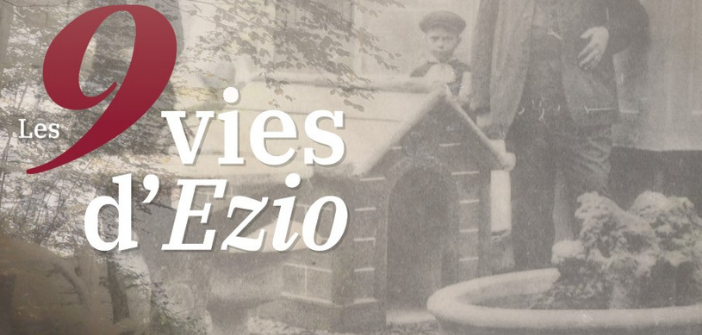I am going to discuss my latest reading here, which leaves me with mixed feelings: The 9 Lives of Ezio, told by his descendant, Jean-Marie Darmian, is a novel that traces the real life of the main character. The book was published by Éditions des Auteurs des Livres in 2020.
The work sweeps through the tumultuous existence of Ezio, from an Italian family originally from Postua, in the Piedmont region.
A rich story weaved with ruptures and perseverance in a Europe sinking into fascism.
The starting point? The Great War, a crucial moment when Giovanni is enlisted in the Italian army, leaving his wife and firstborn alone. As history books taught us in school, women kept the machine running while men were at war. In this crippled organization, the matriarchal system took root.
Today, we readily acknowledge the place of women in Italian society, known for its machismo yet reputed for their character. After all, the film The Godfather (1972) says, “In Sicily, women are more dangerous than shotguns.” While Gesuina is not dangerous, she is portrayed as a force of nature.
Upon returning from the front, young Ezio has grown up and discovers what a father-son relationship is, initially timid, then fusion.
The two men in the family grow closer: Giovanni can resume his hobbies, dedicating himself to his passion for masonry without limits. Little Ezio is admiring: this model child, wise and efficient, could be a budding genius, a notion confirmed as he gets his school certificate with near-perfect results. Unfortunately, the cantonal prize is denied to him. The reason is abject: Ezio the Italian will not be decorated. This hammer blow reminds us of the sad reality of the historical context in which the boy grows up.
Even if the Bazania clan is tight-knit, racism and xenophobia impede the ambitious rise of the family head, who wants to shine in modern masonry. In this multicultural context, Ezio evolves between two countries: France and Italy. At home, they speak Italian, Piedmontese, and French. Just months before his first steps into high school, Ezio suddenly loses his father. Having survived the horrors of war, he dies at sea, on the French coasts. This trauma instills in him the desire to become a doctor, a goal he will achieve brilliantly. His mother is paralyzed, her role gradually diminishing in the narrative, giving the impression she’s fading, though she never truly disappears. The Bazania son excels in his studies and makes Gesuina proud. With a higher education degree, he is set for a promising medical career. Yet, the terrible rise of totalitarianism and the carabinieri militia thwart those plans. On holiday in Italy, on his family lands, Ezio must return to France, where he is conscripted to fight in the name of Mussolini’s Fascism. As he aims for a medical career, we share his frustration at seeing him anywhere but a medical office or hospital. Thanks to his family’s intelligence combined with his courage, Ezio crosses Switzerland. Despite tensions and potential twists, the young man reunites with his mother in Terressauve. His medical training brings him to the brink of success: as he prepares his future practice and is recently married to Yolande, Ezio is solicited by the Compulsory Work Service (STO). There, a betrayal charge follows an airstrike he survives. The sentence is severe: ten years in a forced labor camp. There, he bonds with fellow prisoners. The living conditions are deplorable, making his release feel just as relieving, as he rejoins his wife and mother. The final part of the book serves as an epilogue, reassuring us of Ezio’s long and happy destiny, leaving us with the impression he has become an ally, a companion well-known to us.
This vibrant testimony, offered by the hero’s true family, is a glowing portrait of an ancestor who survived the worst. It is hard not to be attached to this fighter, the rightful son of Gesuina, strong and determined, and his father Giovanni, ambitious and dedicated to his work. Unfortunately, though it is a life story, Ezio’s actions lack psychological development due to the writer’s concise style. Perhaps it is an attempt to portray the daily life of an immigrant, settled in France, as faithfully as possible? The use of dialogues adds substance to the paper pages: the Italian parts truly immerse us in the author’s family. It is a life story, written with a certain imbalance in the narrative text’s organization, especially with important periods for Ezio that either drag on or remain underexplored. Ultimately, the writer highlights the three most striking stages in Ezio’s journey (though this is only my interpretation): the rejection of the cantonal prize, his flight from Italy, and the routine in the forced labor camp. The book would have benefitted from being longer and thicker, as this express read was completed in one evening. This is a sign of a captivating moment, as it is hard to put down the pages. The feeling of a “happy ending” is rare in war narratives. Usually, one leaves the story feeling worn by the experience, but not here. Indeed, it is not only the testimony of an Italian immigrant and a survivor, but above all, it is the portrait of a man who truly existed, like so many others, whose memories may not always endure. History may be woven with great names, generals, and state representatives, but it is indeed the people who give nations their value through blood, shadow heroes, like Ezio Baziana.


